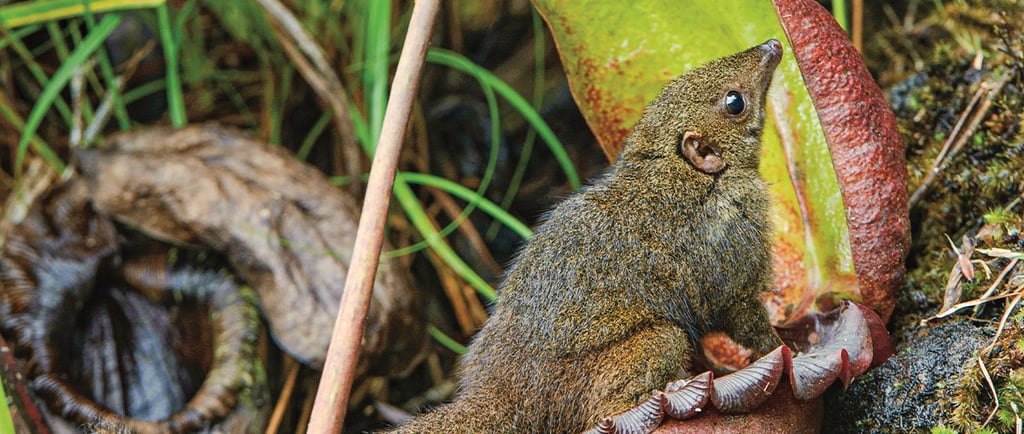🌱The Plant with a Clever Plan ✨🚽 Shrew’s Loo💩
This story is branching from the chapter THE LEAF in the Biology Album. And bridges to other two chapters from the Biology Album : The Zoology, and Ecology. 🐾🌿All plants need nutrients to grow, but what happens when the soil doesn’t have enough nutrients? Some plants, like our clever pitcher plant, find extraordinary ways to meet their needs. Plants rely on the roots to seek and deliver vital nutrients to the food factories, but this plant rewrites the rules, by modifying some of its leafs to guide creatures inside, fulfilling its nutrient needs. In Zoology, we explore partnerships between plants and animals, like how this plant offers shre's sweet treat in exchange for fertilizer. And Ecology reveals how living organisms adapt, with this plant thriving in poor soils by recycling nutrients through its guests. 🏞️✨ This story invites children to uncover the invisible connections between plants, animals, and the ecosystems they call home. 🌍💭 The more we uncover, the more we see that every living being, no matter how unusual, plays a role in the cosmic dance of life. ✨
BIOLOGY STORIES
1/29/20253 min read


Plants have clever ways to eat and survive! 🌿 Most plants rely on their roots to absorb nutrients from the soil, delivering them up the stem to their leaves, and with the help of the sunlight they turn this nutrients into food—cookies for the plant! 🍪 But have you ever wondered what happens if the soil doesn’t have enough nutrients? 🌱 My story today is about one very clever plant adaptation!
This plant came up with an extraordinary plan to make food and deliver all the nutrients it needs to survive. The leaves of this plant are no ordinary food factories!
Let me introduce you this plant with a clever plan that’s breaking all the rules: the pitcher plant from the genus Nepenthes! 👏 Ne 👏 pen 👏 thes 👏. This plant has a big challenge: it lives in some of the poorest soils, where the roots struggle to find enough nutrients to absorb. And without nutrients, the plant can’t make its energy cookies to survive! But don’t worry—the pitcher plant had a brilliant idea. 🌿🚨It transformed some of its leaves into a modified leaf pitcher trap turning a problem into an incredible solution!
The name pitcher comes from Old French pichier, which means a container for holding liquid. 🏺 🏺 And the pitcher-shaped leaf isn’t just for show—it’s filled with a special digestive liquid, like a soup, waiting to break down anything that falls inside. The rim of the pitcher, called the peristome 👏 pe 👏 ris 👏 tome 👏, from the Greek peri- meaning “around” and stomameaning “mouth”, is super slippery, especially when wet. It’s almost impossible for insects to escape once they fall in! 🐜🦟 These unlucky visitors aren’t the main focus, but they’re a nice bonus! The pitcher plant gets most of its nutrients from its clever partnerships with other visitors. The offers sweet nectar in exchange for… well, some Poop. 💩✨
Before you laugh too hard, or “Eww!” too loud, think about his genius plan! Think about how this plant has evolved a truly unique way to survive. There's just one requirement, the Nepenthes does not need just any random poop! 🌿✨Only the animals which have nitrogen rich poop are invited to use this fancy loo!
One of his favorite visitors is the tree shrew. These little shrews are attracted by the delicious nectar the pitcher plant secretes along the edge of its “lid.” While the shrew licks the lid and enjoys its sugary treat. And what happens next?You guessed it—what goes in must come out! The shrew does its business—right into the plant! The pitcher plant doesn’t mind at all; in fact, it’s thrilled because those droppings called guano👏 gua-no 👏 are full of nitrogen. Exactly what the plant needs!🐾🌿
🌿🐵 Here’s something even funnier! According to local legends, monkeys have been seen drinking rainwater collected in the “pitchers,” which is why this plant is also called Monkey Jars! 🐒🏺 The pitchers collect rainwater at the top, and while this might sound risky because of the digestive liquid inside, there’s no danger to the monkeys. The digestive liquid sits deeper inside the pitcher, and the rainwater floats on top. 🌧️💧 So, the monkeys simply sip the fresh rainwater without touching the digestive liquid. Just imagine sipping from nature’s loo! 🚽💩 Since some of the visitors leave their “payment” behind, there might be a surprise ingredient in that rainwater. Will you dare to take a sip?🐒✨🍹
But not all Nepenthes pitchers are attracting tree shrews. Some species offer a luxury hotel for bats . 🦇✨ Bats to curl up inside during the day, to have a good rest. In return, the bats leave behind their droppings, which, you guessed it, are full of valuable nitrogen.
🌿Many plants form unique partnerships all for their survival. Unable to gather all the nutrients they need from the soil through their roots, the pitcher plant has found clever and fascinating ways to thrive. 🐾💩🌱💪 This brilliant adaptation shows how living things work together in nature, choosing to evolve and adapt—not to wither away! 🌍💡✨
I wonder…💭 What other animals might visit Nepenthes pitcher plants? Are there other plants that team up with animals or insects in such clever ways? 🐿️🦋🌍✨
With Montessori joy,
Vanina 😊

